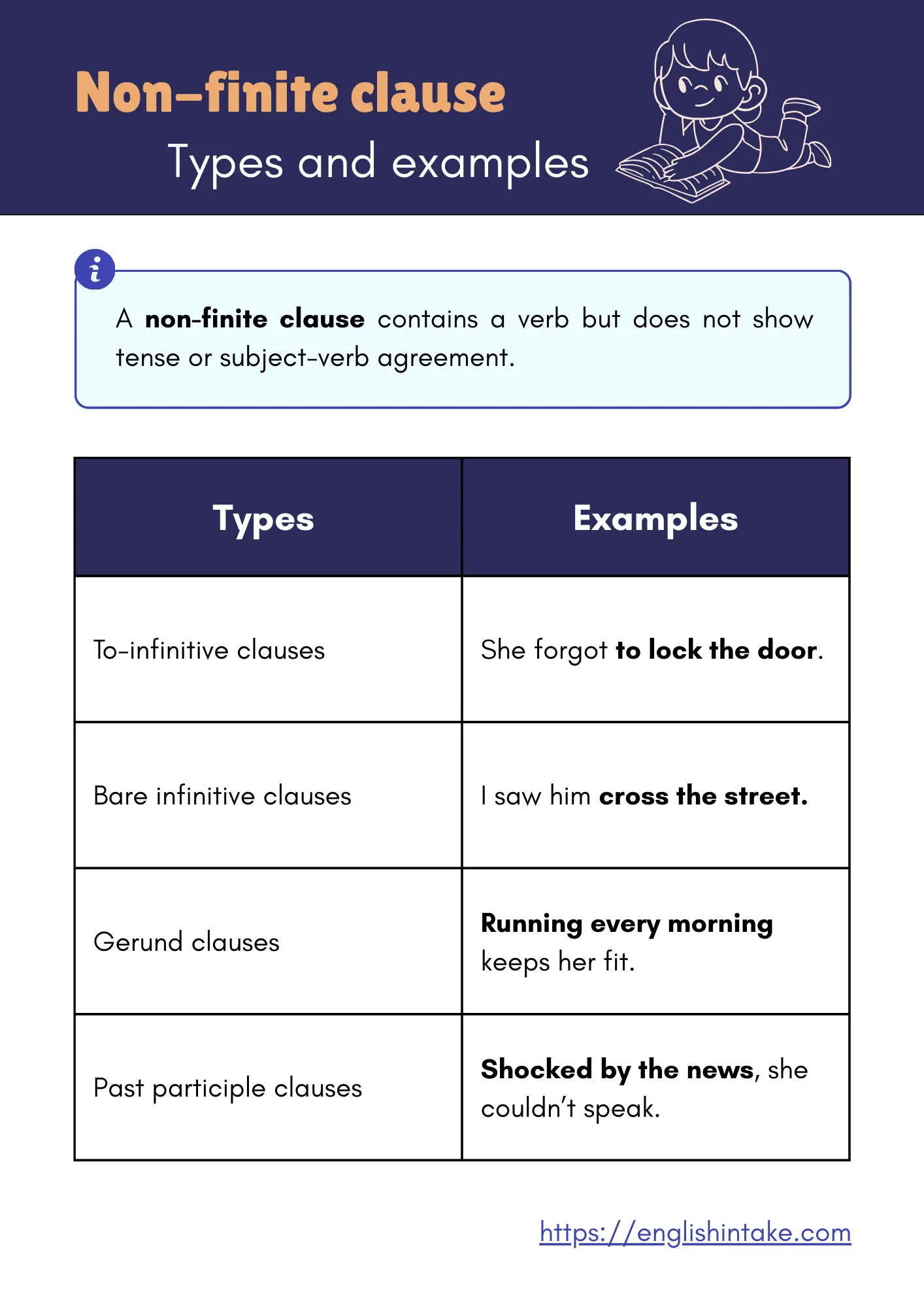1. What are non-finite clauses?
In English grammar, a non-finite clause is a group of words that contains a verb but does not show tense (past, present, or future) or subject-verb agreement. These clauses can act as nouns, adjectives, or adverbs in sentences, adding detail or context without forming a complete sentence on their own.
They are called 'non-finite' because the verb is not limited by a subject – it doesn’t change based on who or what is doing the action. Non-finite clauses depend on an independent clause to form a meaningful sentence.
1. To learn English is her goal.
2. She bought a book written by her favourite author.
3. He ran fast to catch the bus.
4. Backed by Rwandan troops, M23 continues its progress in South Kivu.
5. She rushed to catch the train, forgetting her bags.

2. Using non-finite clauses with subordinating conjunctions
Non-finite clauses (e.g., -ing, -ed, or to + verb) are often used after subordinating conjunctions such as after, although, though, and if.
1. After finishing her work, she went home.
2. Although tired, he continued working.
3. Though nervous, she gave a great presentation.
4. If approved, the construction will start next month.
5. While waiting for the bus, he read a book.
6. When sensing a danger, my dog can attack.
7. Since moving to the city, he has made many friends.
8. Unless solved, the problem will get worse.
3. Types of non-finite clauses
There are four main types of non-finite clauses in English:
1. To-infinitive clauses: She wants to write a novel.
2. Bare infinitive clauses: They helped clear the table.
3. Gerund or present participle: Writing a novel is her dream.
4. Past participle clauses: Written in haste, the letter had many errors.
3.1 To-infinitive
A to-infinitive clause is a type of non-finite clause that uses the structure to + base verb (e.g., to write, to talk). If the independent clause is removed, the sentence will remain incomplete and lack a clear meaning.
1. To write a novel is my passion.
2. I find it best to ask for help when necessary.
3. To play the piano is not my thing.
4. My wife like to go shopping..
3.2 Bare infinitive
A bare infinitive clause uses the base form of the verb without "to" (e.g., write, play). These clauses often follow certain verbs (e.g., make, let, see) or modal verbs. Without the main clause, the sentence is incomplete.
1. They made him leave early.
2. Let her speak first.
3. I saw them cross the street.
4. She can sing beautifully.
3.3 Gerund or present participle
A gerund clause uses the -ing form of the verb functioning as a noun (e.g., writing, reading). These clauses can act as the subject, object, or complement in a sentence. Removing the main clause will leave the sentence incomplete.
1. Writing a novel takes dedication.
2. He enjoys reading before bed.
3. Swimming is a great exercise.
4. We discussed travelling abroad next summer.
3.4 Past participle clauses
A past participle clause uses the past participle form of the verb (e.g., written, broken) and often expresses a passive meaning or shows reason, time, or condition. These clauses usually function as adverbials, adding information about the main clause.
Examples:
1. Written by a famous author, the book became a bestseller.
2. Tired after the journey, they went straight to bed.
3. Built in 1920, the bridge is still in use today.
4. Surprised by the news, she paused for a moment.
4. Special features
Non-finite clauses have unique characteristics:
1. Secondary verb forms: The verb is in a non-finite form (e.g., to write, writing).
2. Special subordinators: Words like to and for can introduce non-finite clauses.
3. No overt subject: The subject is often implied or shared with the main clause.
4. Non-nominative case: Pronouns in non-finite clauses may use non-nominative forms (e.g., for him to go).
- She asked for him to leave. (Non-nominative pronoun)
- To succeed, one must work hard. (Implied subject: one)
5. Non-finite clauses as adjuncts
Non-finite clauses can function as adjuncts to provide additional information about the main clause. However, if the subject is missing, it can lead to dangling modifiers.
Example of a dangling modifier:
1. Walking to work, the rain started. (Who was walking? The rain didn’t walk.)
2. Corrected: Walking to work, I got caught in the rain.
6. Catenative complements
Catenative complements are non-finite clauses that follow certain verbs, forming chains of verbs. These constructions are common in English and can include multiple non-finite clauses.
1. She seems to want to try to finish the project.
2. They helped us clear the table. (Complex catenative)
Raised vs. ordinary subjects
In catenative constructions, subjects can be raised or ordinary:
1. Raised subjects: The subject is semantically part of the subordinate clause (e.g., It seems to be raining).
2. Ordinary subjects: The subject is semantically part of the main clause (e.g., She hopes to win).
1. It seems to be raining. (Raised subject)
2. She hopes to win. (Ordinary subject)
